How to Write a CV Personal Statement [+4 Real-life Examples]

Creating an effective CV takes time and close attention to detail. You've already included your jobs and experience , and now you want to allow the recruiter or hiring manager to understand the strategic value you can add.
This is when you need to utilize a personal statement at the top of your CV.

How to Write a CV Personal Statement [+4 Real-life Examples]

What is a Personal Statement?
A personal statement is a few brief and direct sentences at the top of your CV. The personal statement is also referred to as a career summary or personal mission statement.
This is used to grab the attention of the recruiter or hiring manager and summarizes essential experiences or training that you can bring to this position.
Why do I Need a Personal Statement?
A recruiter or hiring manager is tasked with sorting through an enormous amount of resumes every single day. A personal statement is a way to separate yourself from the other applicants.
This statement summarizes your experience and highlights your unique talents . The CV personal statement is meant to demonstrate why you are the perfect fit for the job.
Even med students need a medical school personal statement , as it is what differentiates them from all the other students applying. Plus, it allows them to share their personal stories and objectives.
Where do I Start?
Always begin by reading the job description carefully and thoroughly.
Your personal statement should be tailored to each job description, so it explicitly states the value you’ll bring to the position you are applying. A generic personal statement cannot do that.
Once you have a solid handle on the job description, you can begin writing. It’s important to keep your personal statement brief, about 50-200 words will do.
Don’t forget that you have your whole cover letter to show some personality and include engaging content.
The personal statement should be a quick summary that highlights why you are the best person for the job.
You’ll need to decide whether you are writing your personal statement in first- or third-person. This should follow how you've written the rest of your CV.
For example, if you've already written, “I grew and developed a team of 50 salespeople,” in your CV then you will want to keep your personal statement in first-person to match the prevailing style.
No matter what you choose, make sure that you keep it consistent throughout. Do not switch between first- and third-person as that will get confusing to the hiring manager.
Writing a personal statement for your CV in first-person does not mean you need to start every sentence with “I.”
There are ways to craft your personal statement to sound snappy, concise and personal, and here are a few examples to help inspire your personal statement.
CV Personal Statement Examples
It doesn’t matter what chose as your desired career or how much experienc e you have, use these examples to drive the creation of your own personal statement.
You can take snippets from each or write something completely different. Always remember that your personal statement is a reflection of yourself and should align with your own personal goals and experience.
If these examples don’t fit your exact career, feel free to take some pointers and write yours from scratch.
#1: Personal Statement Example for Recent Graduate CV
“As a recent graduate from university, with an honors degree in communications, I held several internships within leading organizations, including Bertelsmann. These internships enabled me to gain experience in the field and learn how to serve up valuable contributions in a fast-paced, professional environment.”
Explanation: This example should be customized to include the university you’ve graduated from and any relevant internships. A compelling personal statement always highlights relevant skills and experiences.
In this case, a recent graduate does not have extensive experience in the workforce, so soft skills like experiencing success in a fast-paced work environment and becoming a trusted team member become even more critical.
#2: Personal Statement Example for Returning to the Workforce CV
“A highly motivated and experienced office administrator, I am currently looking to resume my professional career after an extended hiatus to raise my family. Proficient in all Microsoft Office programs, I can lead meetings and work with clients to keep your office running smoothly and efficiently. After spending several years volunteering as an administrative worker for a local charity, I am committed to resuming my professional career on a full-time basis.”
Explanation: After time off from a career, it can be hard to break back into the market. This personal statement outlines the reason for the break, the relevant qualifications and what the applicant has been doing in between jobs.
Any volunteer experience becomes highly relevant when there is no concrete professional experience to draw upon, to demonstrate the use of those skills.

#3: Personal Statement Example for a Career Change CV
“With over 15 years as a sales manager, I have extensive experience building high-functioning sales teams that consistently achieve budget numbers. In fact, my ability to grow talent led to a 20% increase in annual renewals across the board. Now, after 15 years, I am seeking new challenges to flex my marketing muscles in a fast-paced environment.”
Explanation: When changing careers , it's essential to highlight skills that are transferable between industries.
In this case, leadership and team-building experience can apply to any industry. Homing in on concrete numbers and percentages increases credibility when applying for a position.
The applicant ends with the reason behind the desired career change. This part is not necessary but may be appealing to some hiring managers who are wondering what the impetus for the career change.
#4: Personal Statement Example for a Experienced Professional CV
“As a friendly, professional and highly trained educator, I am passionate about teaching and have an innate ability to understand student’s needs. Creating a safe and productive environment for optimal learning is my top priority. I’ve worked as a teacher for nearly 10 years in a variety of subjects and my experience and skill set make me the perfect fit for your team.”
Explanation: With more experience comes more skills and a better idea of strengths and weaknesses. Showcasing your passion for the industry is a great way to begin a personal statement, as it shows the hiring manager your dedication to the craft.
A personal statement can be written in many different ways, but it is ultimately up to you to determine what skills you want to highlight for your chosen position.
You can follow these examples or take learnings from each to contribute towards your personal statement.
If you understand the job you are applying for and know the unique skill set that you bring to the table, you will have a stellar personal statement for your CV that will get you across the table from the hiring manager in no time.
Suggested Reading:
- How to Write a CV (Curriculum Vitae) in 2024 [31+ Examples]
- 43+ Resume Tips and Tricks to Land Your Next Job
- 150+ Must-Have Skills for Any Resume [With Tips + Tricks]
- How to Answer “Tell Me About Yourself”

To provide a safer experience, the best content and great communication, we use cookies. Learn how we use them for non-authenticated users.
How to write a personal statement
Present yourself clearly and concisely
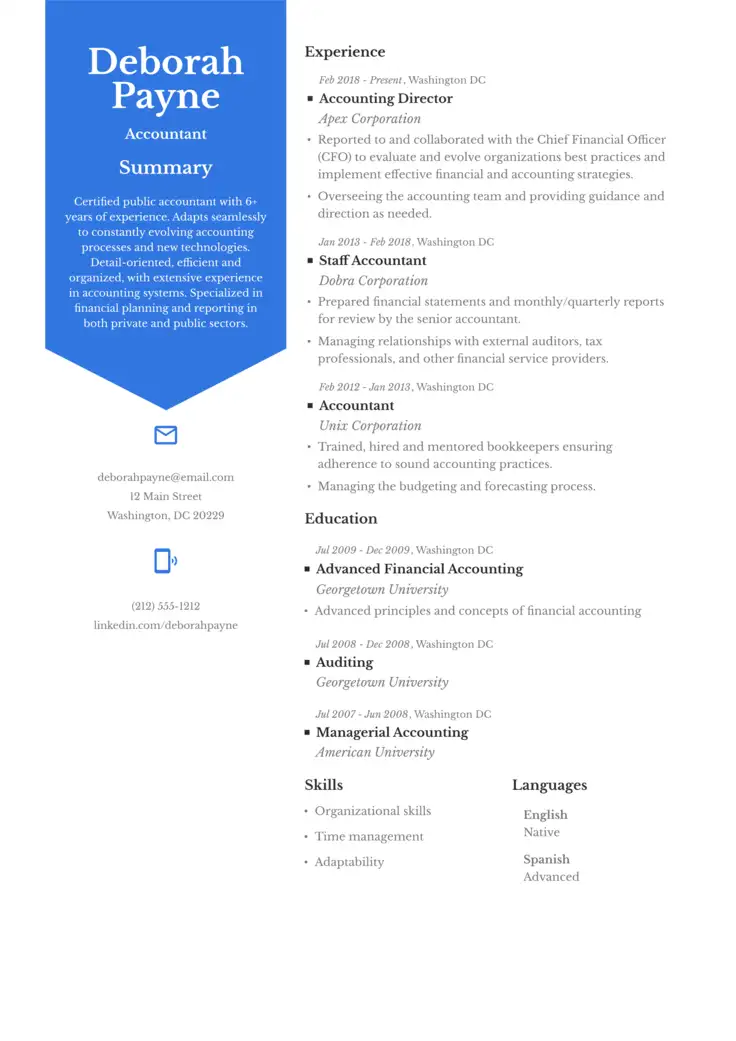
How to write an effective personal statement for a CV
Writing a personal statement for your CV is crucial in making a strong first impression . It serves as a snapshot of your professional identity, showcasing your key qualities, skills, and relevant experiences in alignment with the job you’re applying for.
By effectively summarising your strongest points , you demonstrate to hiring managers why you stand out in the field, making them eager to learn more about you.
Use our AI-powered online CV builder to create a CV and worry less about things such as format or design.
Key strategies for crafting engaging personal statements
When writing your CV personal profile, these tips serve both as guidance and a checklist to ensure your statement stands out.
Keep it concise
- Aim for a short and impactful statement; brevity encourages hiring managers to delve deeper into your CV.
- Highlight your “ valuable work experience ” or “extensive work history” compellingly.
Choose your words wisely
- Opt for original adjectives and power words , steering clear of clichés like “hard-working”.
- Maintain a positive tone throughout your statement.
Craft a captivating narrative
- Avoid focusing too long on a single achievement .
- Start with an engaging sentence, listing your key attributes and what you can bring to the company, concluding with a strong, memorable line.
Align with the company
- Tailor your personal statement for each job application to reflect alignment with the specific role.
Proofread thoroughly
- Ensure your personal statement and entire CV are free from typos , as errors undermine professionalism.
- Reading aloud can help identify areas for improvement in strength and flow.
Starting your statement
- If you’re unsure where to begin, consider answering simple interview questions about yourself. Use these responses to build a dynamic and professional narrative.
Final touches
Perfect your draft by connecting ideas with linking words , and refining your content for clarity and impact .
Optimising for ATS compatibility
Many employers rely on Applicant Tracking Systems (ATS) to streamline their recruitment processes. These digital gatekeepers scan and filter CVs , including personal statements, to identify the most relevant candidates.
To ensure your personal statement isn’t overlooked, it’s crucial to understand how to make it ATS-friendly .
- Research key terms : Start by reviewing the job description and industry-specific terminology. Identify keywords or phrases that frequently appear. These could include job titles, technical skills, certifications, or industry buzzwords.
- Strategic placement : Once you’ve identified the keywords, strategically incorporate them into your personal statement. Avoid cramming them all into one sentence; instead, weave them naturally into your narrative.
- Avoid overloading : While it’s essential to include relevant keywords, don’t overdo it. ATS systems may penalise excessive keyword stuffing. Aim for a balance between readability and keyword inclusion.
- Synonyms and variations : ATS systems often recognise synonyms and variations of keywords. For instance, if ‘leadership’ is a keyword, ‘team leadership’ or ‘leadership skills’ may also be relevant. Consider using synonyms where appropriate.
- Tailor to each application : Remember that not all keywords are universal. Tailor your personal statement for each job application by adjusting keywords to match the specific role’s requirements. This demonstrates your genuine interest and suitability for the position.
By integrating relevant keywords into your personal statement, you increase your chances of passing through ATS filters and catching the recruiter’s attention.
Striking the right balance between keyword optimisation and a compelling narrative is the key to crafting an ATS-compatible personal statement that resonates with potential employers.
What’s the difference between a career objective and a personal statement?
Understanding the nuances between a career objective and a personal statement is key in tailoring your application , whether for a job or university admission.
Each serves a distinct purpose in presenting your professional ambitions and personal achievements.
Career objective: a glimpse into your future
A career objective focuses on your aspirations and the professional milestones you aim to achieve. Typically more succinct than a personal statement, it doesn’t elaborate on past job roles or academic achievements.
Instead, it showcases your ambition and direction within your chosen field, articulating why a particular job aligns with your career plans and underlying motivation.
Personal statement: the comprehensive summary
In contrast, a personal statement offers a broader overview, including your key traits and achievements , and how these support the job requirements.
It acts as a brief yet comprehensive presentation of your professional persona , rather than explicitly setting career targets.
CV vs university applications: Know the difference
Personal statements on cvs.
For job applications, your personal statement is a short paragraph designed to highlight what makes you the ideal candidate , distinctly setting you apart from other applicants.
Personal statements for university applications
Conversely, a personal statement for university admissions is considerably lengthier , providing a detailed account of your academic background , interests, and personal interests .
It’s important to recognise and adapt to the differing expectations of these contexts.
Crafting your CV: flexibility in format
Whether you opt for a career objective or a personal statement depends on your preference and the specific demands of the job you’re applying for. Utilising a CV template can simplify the process , offering customisable options to match your style and the application’s requirements.
When should you include a personal statement on your CV?
If it is not necessary to include a cover letter with your job application, you can add a personal statement to your CV to give a more personal and explanatory touch to your profile .
Regardless of whether or not it is necessary to include a cover letter with your job application, you can still include a personal statement in your CV format . The choice is entirely up to you .
We recommend writing a personal statement , as it is a productive way of presenting yourself to hiring managers with a short summary of your profile.
Do’s and don’ts of writing personal statements
Streamline your personal statement with these essential do’s and don’ts , ensuring immediate impact:
Be concise : write a brief, impactful summary.
Tailor to job : highlight relevant skills.
Use positive language : show enthusiasm.
Proofread : ensure there are no errors.
Personalise : emphasise what sets you apart.
Don’t👎
Overuse jargon : avoid excess technical terms.
Be vague : specify achievements and skills. Use metrics.
Repeat CV : offer new insights, not duplicates.
Undersell : highlight your achievements.
Ignore basics : address ‘Who you are’ and ‘What you offer’.
Remember, your personal statement is your opportunity to make a memorable first impression. Keep it relevant, engaging, and reflective of your unique professional journey.
CV personal statement examples
Struggling to write the perfect personal statement for your CV ? Have a look at some of the examples below for some inspiration.
Graphic design
Recent graduate with a first-class honours degree in Graphic Communication Design from the University of Exeter. Valuable work experience in illustration, publication and online web design. Looking for a challenging job role based in London where I can jumpstart my career and develop my graphic design expertise.
Proactive primary school teacher with over seven years of experience specialising in Science and Maths, as well as Foreign Languages. Fluent in both German and French, looking for a secure job position in East Sussex where I can incorporate modern and innovative teaching techniques to motivate pupils.
Highly driven sales professional with four years experience working for two successful companies in Birmingham. Over the last few years, my sales targets have increased due to my quick working pace and progress, leaving me with the belief and certainty of my capability for the role of sales manager.
Business developer
Motivated and enthusiastic individual, who has recently achieved A levels in Business, Media and French at Havant College. Looking for a business apprenticeship where I can begin my career and reach my eventual goal of a successful business developer in the international media sector.
A typical personal statement should ideally be around 150 words in length . It’s important to be concise while conveying your key qualifications, experiences, and aspirations. Adhering to this word limit ensures that your statement is engaging and to the point, capturing the recruiter’s attention without overwhelming them with excessive details. However, always check the specific requirements provided by the employer, as some may request a different length for personal statements.
A good personal statement for a CV is a concise, well-structured paragraph that highlights your key qualifications, skills, and aspirations , tailored to the job you’re applying for. It should capture the employer’s attention, showcase your unique strengths, and demonstrate your enthusiasm for the role. Avoid clichés and instead focus on specific achievements and experiences that make you a strong fit. A successful personal statement should leave a lasting impression and make the recruiter eager to explore your CV further .
Including personal achievements and hobbies in your personal statement can be beneficial if they are relevant to the job or reflect key skills . Highlight achievements that demonstrate qualities like teamwork, leadership, or problem-solving. Relevant hobbies can showcase your passion or expertise in areas related to the role. However, avoid listing unrelated or generic interests . Prioritise achievements and hobbies that enhance your suitability for the position and align with the employer’s expectations to create a more compelling personal statement.
While a well-crafted personal statement can certainly strengthen your job application , it may not entirely compensate for a significant lack of experience or qualifications. It can, however, help you explain transferable skills , your enthusiasm for the role, and a strong cultural fit. To increase your chances, focus on showcasing relevant skills and demonstrating your commitment to learning and growth in the personal statement. Remember that some employers prioritise potential and attitude over qualifications, so crafting a persuasive personal statement remains valuable even in such situations.

Struggling with CV Writing?
Ease the process with our templates
- Knowledge Base
- Free Resume Templates
- Resume Builder
- Resume Examples
- Free Resume Review
Are you familiar with the resume personal statement?
It is the quickest way to introduce yourself to the recruiters and lay out your professional prospects in a short statement.
A resume personal statement can do the talking for you if crafted in the right way.
Let us discuss in detail about CV personal statement and get you started with all the dos and don'ts around it.
You can also get a deeper understanding of the following FAQs around resume personal statement:
- What is a good personal summary for a resume?
- Should I include a personal statement on my resume??
- What should you include in a personal statement?
- What is a resume summary and objective?
What Is a Personal Statement on a Resume?
A resume personal statement is like a summary or objective of your resume.
It is a short paragraph that sums up your work experience, skills set, and achievements. A CV personal statement validates your efficiency as a professional.
The resume personal statements consist of the following points:
- An introduction of who you are
- The value you add to the organization
- The objectives of your career
This short statement works magic on the recruiters during job applications. It makes it easier for them to identify your core skills and potential while raising your chances of landing the targeted job profile.
Also Read: How to Write Resume Summary Statement?
Do You Need a Personal Statement on a Resume?
Providing a resume personal statement is important as it makes it easier for the recruiters to recognize your potential right away.
The main benefits of a resume personal statement are listed below:
- It enables you to introduce yourself to the recruiters
- It gives you the chance to showcase what you can bring to the table
- It allows you to highlight your professional achievements
- It provides you the opportunity to showcase your skills and strengths
- It allows you to share your career goals or objectives
Simply put, resume personal statements are the window to your resume, and adding them to your resume can communicate your potential to the recruiters.
How to Write a Resume Personal Statement?
While some may think that drafting a resume statement is a complicated task, you should know that it is quite easy if done the right way.
You need to add only the important points that validate your professional capabilities in a resume summary statement.
Here is what you need to do to create the perfect CV personal statement.

Follow the given guideline to make your resume stand out amongst hundreds of applicants:
1. Introduce Yourself
Start your resume personal statement by introducing your professional self. Doing so will make the recruiters identify where you stand professionally right away.
Example: 5+ years experienced software engineer with a prolific track record in software and IT management.
From the given example, we can see how a short sentence is enough to make an impactful first impression on the recruiters.
It states who you are as a professional by highlighting your current or most recent job profile. It also states the years of experience and level of specialization you possess.
The trick here is to state the years of experience you possess and give an insight into your professional background.
2. Add Your Professional Achievements
State what you have achieved during your professional experience to demonstrate that you have the potential to produce desired results for the organization.
Example: Possesses extensive experience in administering development, implementation, and management of IT systems, resulting in improved accessibility.
This allows the recruiters to assess your caliber and determine your suitability for the targeted profile.
3. Mention Your Core Skills
A resume personal statement is not the place for you to brag about every skill that you possess, but a subtle mention of what your core skills are is enough.
Example: Highly skilled with Linux and Unix server architecture combined with an in-depth knowledge of a range of technological applications.
Mentioning some relevant skills, as shown in the example can make the recruiters recognize your efficiency in specific skills that they require their potential employees to possess.
4. Include Suitable Keywords
The Applicant Tracking System allows the recruiters to filter through hundreds and thousands of resumes to save time and select suitable applicants.
Hence, your resume needs to contain suitable keywords that are relevant to the targeted job profile. And the resume personal statement is one of the best places to include such keywords.
Practice drafting your resume personal statement after the rest of your resume is done and dusted.
Doing so allows you to pick important points and relevant keywords from the details listed in the main context of the resume and shed the spotlight on them.
Example: Junior web developer with 4+ years of experience in assisting the senior manager to develop and implement user interactive internal web pages by using languages such as HTML and CSS to enhance user interactions. Highly skilled in customizing content management systems to manage various website properties and deliver timely site redesigns.
If you are applying for a web developer profile, adding relevant keywords related to web development or programming languages can make your resume get past the ATS with ease.
Difference Between Resume Summary and Objective Statement
Both resume summary and objective statements give an overview of your resume but the messages they deliver are different.
A summary statement describes your qualifications and professional expertise that throws light on your suitability for the targeted job profile.
On the other hand, an objective statement describes your career goals and the kind of job or industry that you prefer.
A resume summary highlights what you have achieved and how it can benefit the organization. Whereas an objective highlights what you can bring to the table despite having no or very little experience.
Also Read: How to Draft a Resume Objective Section?
Tips for Writing The Perfect Resume Personal Statement
Here is a list of some dos and don'ts while drafting your resume personal statement:
- Limit your personal statement to 3-4 lines
- Include only important points
- Highlight the years of experience you have (if you are an experienced professional)
- Mention your relevant skills and expertise
- Add relevant keywords as per the job description
- Proofread your resume personal statement
Resume Personal Statement Examples
How do you write a personal statement for a resume?
The personal statement for resume needs to be customized according to the years of experience that you have and the skills that you possess.
Check out the given CV personal statement examples for reference:
Resume Personal Statement for Data Engineer
10+ years experienced data engineer armed with demonstrated capability of designing and maintaining data pipelines to facilitate deeper analysis and meet both functional and non-functional business requirements. Adept at liaising with product owners and business stakeholders to design scalable solutions by optimizing organizational processes. Proficient in creating highly scalable data processing frameworks to ensure a smooth business workflow.
Also Read: How to Create the Best Data Engineer Resume?
Resume Personal Statement for Graphic Designer
Enterprising graphic designer with 5+ years of experience in establishing brands through creative concepts. Proficiency with publishing tools comprising Photoshop, InDesign Quark, Illustrator, and Premiere Pro to deliver top-notch visual content. Efficient in analyzing products to create visuals that justify their worth and establish brands to elevate business growth.
Also Read: How to Curate a Professional Freelance Graphic Designer Resume?
Resume Personal Statement for IT Professional
15+ years experienced IT professional with a proven track record of handling web development, design, and various interactive projects based on languages such as HTML, PHP, SQL, and XML. Highly skilled in leading teams of web developers and programmers to develop state-of-the-art corporate intranet and implement advanced CMS solutions using open source tools and Drupal. Adept at providing dynamic and marketing-friendly front-end solutions to assist management in performing SEO, web analytics, and A/B testing.
Also Read: How to Create a Job-worthy IT Resume?
Resume Personal Statement for Certified Professional
Certified business intelligence developer with 3+ years of experience in designing software solutions by translating business requirements into scalable BI projects. Proficient in ensuring the integrity of data while diagnosing and troubleshooting technological issues.
Also Read: How to List Certifications on Resume?
Key Takeaways
- Draft your personal statement after you complete the rest of your resume.
- Always keep your resume personal statement short and precise within a 3-4 line limit .
- Include details that reflect your achievements and core skills to validate your potential.
- Customize your CV personal statement in line with the job description of the profile that you are applying
- Add suitable keywords in your summary statement to rank high on the ATS
Go to Hiration's 360-degree Career Service platform which has 24/7 chat support for any assistance with all your job & career-related queries.
You can also write to us at [email protected] .

Share this blog
Subscribe to Free Resume Writing Blog by Hiration
Get the latest posts delivered right to your inbox
Stay up to date! Get all the latest & greatest posts delivered straight to your inbox
Is Your Resume ATS Friendly To Get Shortlisted?
Upload your resume for a free expert review.

LIVE MASTERCLASS: 7 Strategies For Parents To Help Your Child Earn $100,000 College Scholarships & Ace The New 2024 Digital SAT. Enroll Free!
Personal Statement Do’s & Don’ts
Your grades and standardized test scores are set by now, so the personal statement is your last chance to add something new to your college applications.
An effective personal statement is well-written, avoids cliches, tells a story about you that shows the admissions committee who you are, and brags a little—but doesn’t show off.
I’ve compiled a list of personal statement ‘do’s’ and ‘don’ts’ to help you as you work your way through your first few drafts.
For even more help with the college admissions process, including boosting that standardized test score, consider taking an SAT prep course or ACT prep course with Prep Expert.
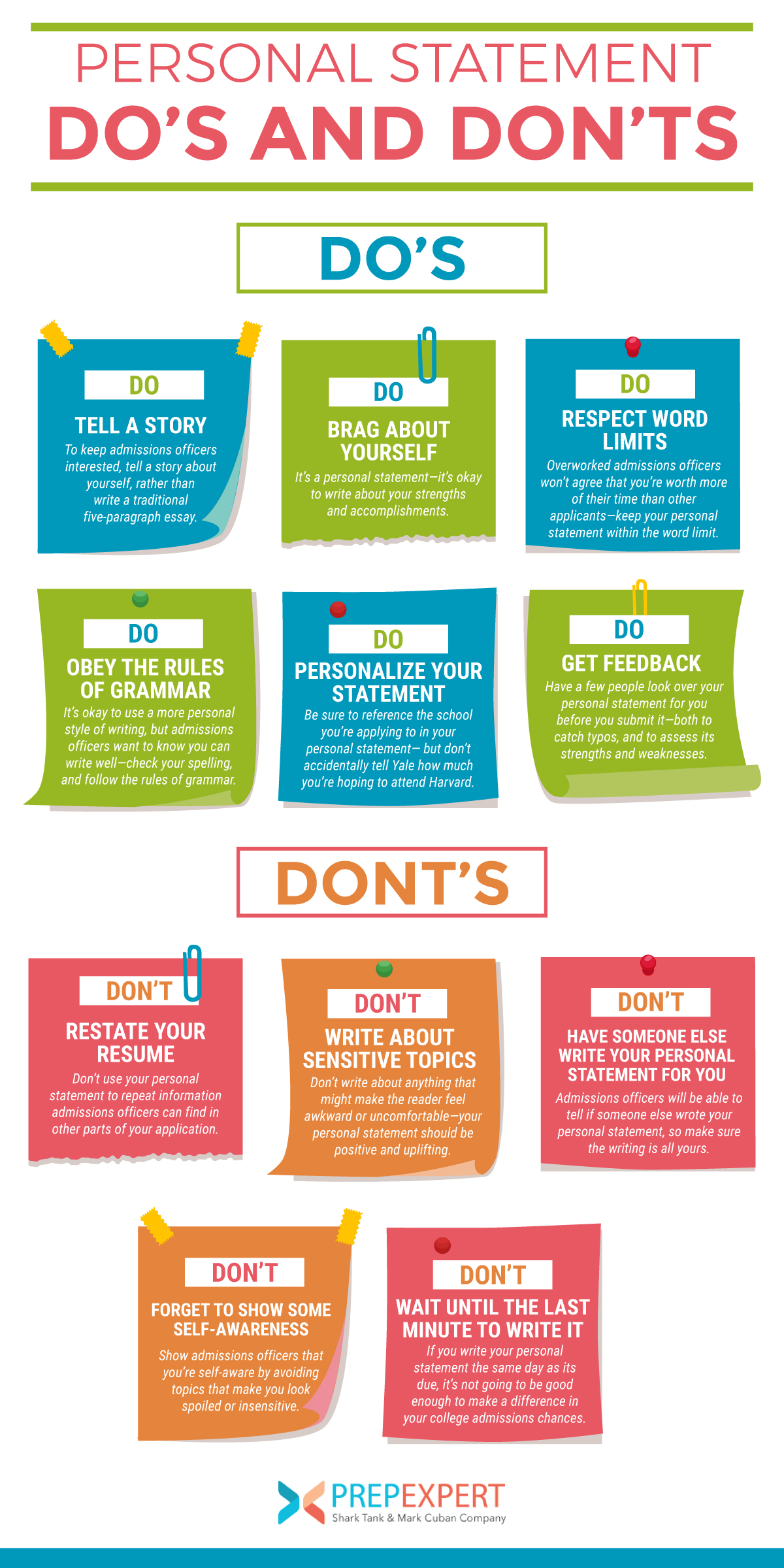
Do Tell A Story
To keep admissions officers interested, tell a story about yourself, rather than write a traditional five-paragraph essay.
Admissions officers read thousands of personal statements every year. You want yours to be compelling and memorable. So, be creative—think about an experience or part of your biography that’s special to you, and write about it.
Avoid topics admissions officers are likely to read about over and over again in other personal statements. Plenty of people have volunteered for Habitat for Humanity or been the captain of their high school basketball team, for example.
Remember, you want to stand out—so, if you do write about something like this, put your own unique spin on it.

Do Brag About Yourself
It’s a personal statement—it’s okay to write about your strengths and accomplishments.
Most people aren’t comfortable bragging about themselves. But that is exactly what to do in your personal statement. Talk about:
- Sccomplishments
- Moments where you made yourself proud
Just be sure to do so tastefully.
How do you strike this balance? Show, don’t tell.
Don’t tell the admissions committee you’re a good person—show them you’re a good person by writing about a good deed that you performed.
Don’t tell them you’re the best basketball player in the state—set the scene and describe how you led your teammates to victory in the championship game.
A good rule of thumb here is to try and use verbs, rather than adjectives.

Do Respect Word Limits
Overworked admissions officers won’t agree that you’re worth more of their time than other applicants—keep your personal statement within the word limit.
Most colleges and universities have a word limit for personal statements. While you might think that you have a particularly compelling story to tell, and need more paragraphs than alotted, don’t give in to this temptation.
Being over by a couple of words isn’t a huge problem—admissions officers aren’t going to count your personal statement word for word—going way over the word limit though will not be a plus for your application.
As mentioned, admissions officers have to read thousands of personal statements every year—so don’t go and give them extra homework.
Besides, you can tell a great story about yourself within the word limit. Being confined to five paragraphs or a couple of pages forces you to write only about the most important and interesting aspects of your story.
If you’re having trouble meeting the word limit, on the other hand, you probably don’t have enough to say about the topic you’ve selected. Go back to the drawing board and try telling a different story.

Do Obey The Rules Of Grammar
It’s okay to use a more personal style of writing, but admissions officers want to know you can write well—check your spelling, and follow the rules of grammar.
Your personal statement is not the place to use slang or casual language. But do show off your command of vocabulary—you want your personal statement to show you’re ready for college-level writing.
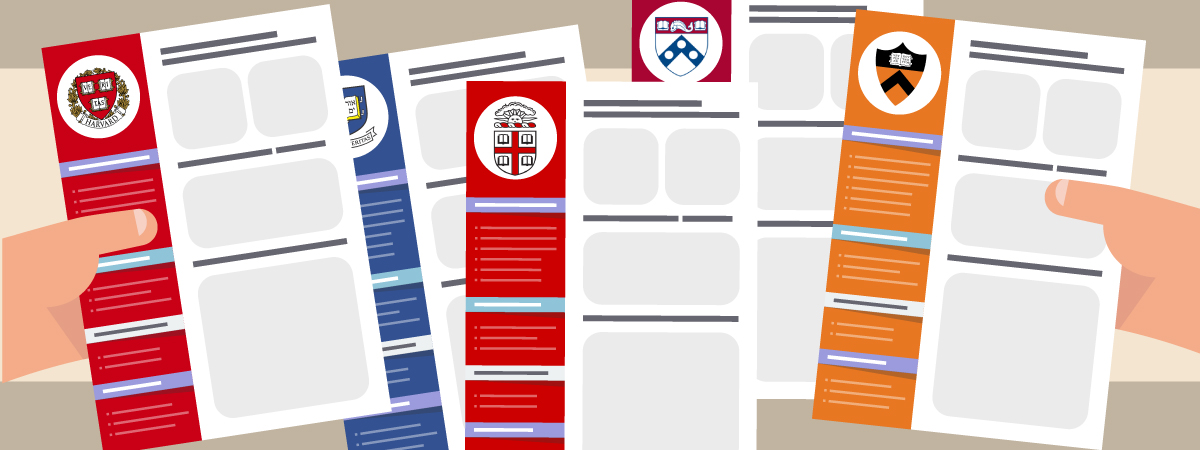
Do Personalize Your Statement
Be sure to reference the school you’re applying to in your personal statement— but don’t accidentally tell Yale how much you’re hoping to attend Harvard.
Even if you’re using the Common Application, you should tailor your personal statement to each school to which you’re applying. Mention the school in your closing paragraph, for example.
It’s fine to recycle the same personal statement for several applications—almost everyone does this—but don’t simply use the find-and-replace function to change the name of the school and be done with it.
Do a thorough once-over to make sure you haven’t accidentally mentioned how much you want to attend Duke in the personal statement you’re sending to Georgetown. (This might seem like a no-brainer, but admissions officials report goofs like this do happen all the time.)

Do Get Feedback
Have a few people look over your personal statement for you before you submit it—both to catch typos, and to assess its strengths and weaknesses.
After all the writing you’ll be doing, you’ll need a few other pairs of eyes to help you see what you’ve been missing. So, once you’ve written a draft of your personal statement, it’s a good idea to show it to others—friends, parents, teachers—and ask their opinions.
Do they think you’ve done a good job introducing yourself to the admissions committee? Did you misspell the college’s name or leave a comma out of place? Let someone else’s fresh perspective tighten up what you’ve put together so far and make it as great as possible.
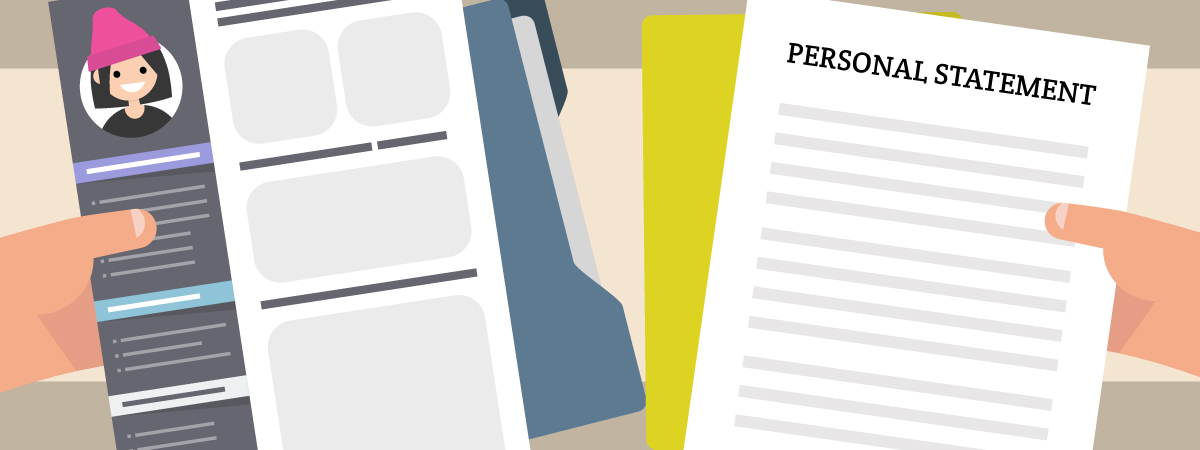
Don’t Restate Your Resume
Don’t use your personal statement to repeat information admissions officers can find in other parts of your application.
You want your personal statement to stand out in a sea of applicants, and you also want to show a side of you that isn’t shown in the other parts of your application. So, don’t make the most common mistake that many applicants make.
That mistake is simply writing a laundry list of your extracurricular activities and academic accomplishments. Admissions officials can already get this information by looking at your application and high school transcript.
[leadmagnet_five]

Don’t Write About Sensitive Topics
Don’t write about anything that might make the reader feel awkward or uncomfortable—your personal statement should be positive and uplifting.
There are certain topics—domestic violence or sexual assault, for example—that might have had a profound impact on your life. You could be tempted to write about these things, to show how you have successfully overcome adversity. Don’t.
Not to downplay these experiences and their personal importance, but these topics, and others like them, are simply too sensitive to write about in a brief personal statement.
It’s not a bad idea to write about how you have overcome adversity, but your personal statement should be positive and leave your reader feeling good, not uncomfortable.

Don’t Have Someone Else Write Your Personal Statement For You
Admissions officers will be able to tell if someone else wrote your personal statement, so make sure the writing is all yours.
This might seem like another no-brainer, but each year, plenty of applicants have someone else write their personal statements for them. These applicants mistakenly think that asking a stronger writer or a native speaker to pen their essay will leave their application in better shape.
However, admissions committees are alert to this practice, and if your ‘voice’ in your personal statement is significantly different from the one in your SAT or ACT essay, admissions officers are going to know they’re not reading your actual writing.
Submitting someone else’s work as your own—better known as plagiarism—is not a good look for your application, and might result in an automatic ding.

Don’t Forget To Show Some Self-Awareness
Show admissions officers that you’re self-aware by avoiding topics that make you look spoiled or insensitive.
Be aware of the advantages you’ve grown up with so far in life. Plenty of students want to write about their life-changing trip to Costa Rica, for example.
But, unless you do so in a way that shows true cultural awareness or engagement with global issues, all you’re really doing is bragging about a really cool vacation that you took.
Unfortunately, that’s not something an admissions officer wants to read about while reviewing a giant pile of applications on their desk.
[leadmagnet_two]
Nor is this type of personal statement likely to reflect well upon you against other applicants, who are writing about topics like being the first in their family to attend college, overcoming an illness, or being an immigrant, for example. Take a minute to think about how your topic choice will come across before writing.

Don’t Wait Until The Last Minute To Write It
If you write your personal statement the same day as its due, it’s not going to be good enough to make a difference in your college admissions chances.
Don’t deprive yourself of the opportunity to write something that’ll catch an admissions officer’s eye, and help you stand out among thousands of other applicants, by procrastinating on your personal statement.
An effective, well-written personal statement takes requires some serious time and thought to do. You should try and get started on it in the summer before your senior year, so when school begins all you have left to do is dot those I’s and cross those t’s.
For more test strategy, college admissions, and scholarship application tips sign up for our FREE class happening right now!
Personal Statement Do’s and Don’ts FAQ
What is a personal statement.
The personal statement is an essay that educates admissions officials about who you are and why you deserve to be admitted to their institution.
What are the elements of an effective personal statement?
How early should i work on writing my personal statement.
You should try and get started on it in the summer before your senior year.
What shouldn’t I do when writing my personal statement?
Don’t restate your resume, wait until the last second, be arrogant, write about controversial topics, or have someone else write it for you.

Related Articles

Meritocracy: Why Top Colleges Have Reinstated SAT & ACT Requirements
Apr 29, 2024
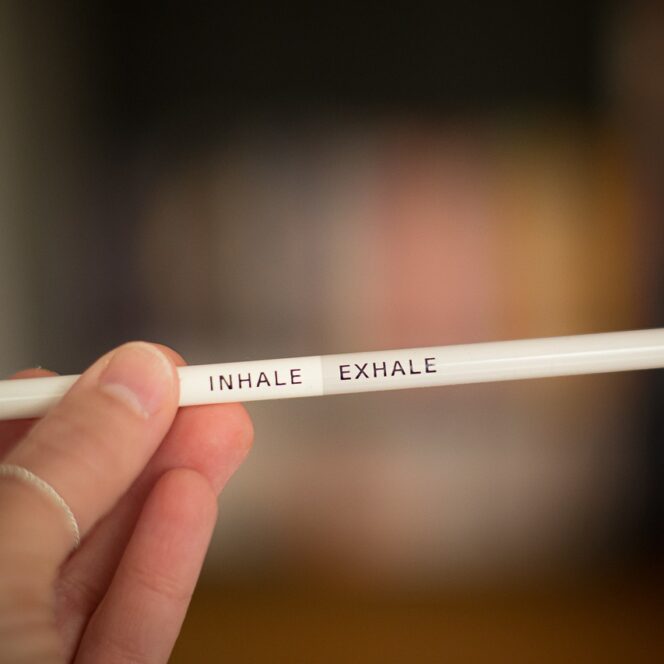
Harvard Brings Back Standardized Testing Requirements
Apr 23, 2024

Navigating the College Admissions Process: A Comprehensive Guide for Parents
Mar 5, 2024
Written by Dr. Shaan Patel MD MBA
Prep Expert Founder & CEO
More from Dr. Shaan Patel MD MBA

7 Reasons Harvard & Yale Reinstated SAT Test Requirements
As the Founder & CEO of Prep Expert, I have dedicated my career to helping students maximize their potential on…

In addition, no two AP classes are alike. For example, AP Biology is typically a difficult course at most high…

Your Ultimate Guide To Digital SAT Prep
https://vimeo.com/919214609 View SAT Courses View SAT Book Digital SAT Prep Welcome to your ultimate guide to preparing for the digital…
$200 OFF COUPON CODE
Subscribe to our emails and get $200 OFF any Prep Expert Online Course.
Enter the coupon code SHARKTANK200 to save $200 OFF any Prep Expert Online Course!
By providing your email address, you agree to our Privacy Policy and Terms & Conditions
No thanks, I’d prefer to pay full price.
Dos and Don’ts when writing your personal statement
Sometimes the smallest detail can let a whole CV down. Your personal statement is the first thing on your CV that a potential employer will read so you want to make sure it sends all the right messages.
Writing a personal statement is not an easy task and might take some time and effort, especially if you’ve never written one before. If you have written a CV and personal statement before, or even many times before, it’s a good idea to regularly go back over what you’ve written in the past to make sure it’s still relevant and appropriate. A bad personal statement can scupper your efforts to land that dream job.
We’ve already covered the basics of why and how to write a personal statement, but below is our list of personal statement dos and don’ts to consider when you’re writing yours.
- Get straight to the point. The best personal statements are short and concise. Cut out anything which is not relevant to the job. Aim for roughly 100-200 words.
- Make sure you cover the key information: who you are, what you can bring to the role, and what career goals you hope to achieve in the future. Using these three key points as guidance will help keep your personal statement structured and relevant.
- Back up what you say with examples or figures. Giving evidence of your statements makes them more credible and keep statements specific.
- Avoid clichés. You want your CV to stand out from the rest, and chances are many other people have included the common cliché statements, and the reader has heard them all before. Keep your CV as individual as possible to stand out from other applicants.
- Use the job description as guidance. You want to show employers that you meet the requirements for the role – follow what’s written in the job description and highlight your strongest skills which are relevant to the job. If you can show that you tick all the boxes of what an employer is looking for your application is much more likely to be shortlisted.
Top tip: use words and phrases like successfully, developed, proven, track-record, experienced, delivering results. Although cliché statements should be avoided, buzzwords like these can help make your CV stand out to a reader.
- Be vague or generic. Although you’ll have to put in more time and effort to tailor each CV you send out, you’ll vastly increase your chances of being hired and so will save time in the long run.
- Focus too much on yourself. Of the three key points to get across you want to focus most on what you can bring to the role that others can’t i.e. why you should be hired over everyone else.
- Include information that should be in your cover letter. Remember that your personal statement is a brief introduction. Keep statements and examples short and concise to get the reader’s attention. You can then elaborate on successes and achievements in your cover letter and employment history.
- Write a list. Try to avoid starting every sentence with “I…” as this soon gets boring and doesn’t serve to tell the reader anything they don’t already know i.e. that your CV is about you! Choose your main points and write them in a short but engaging style.
- Underestimate the benefit of reading your personal statement out loud. This will help make sure it flows nicely. Ask friends or family members to read it back to you. Collectively you’ll be more likely to spot mistakes or awkward wording. You want to make sure the writing of your CV doesn’t let down its content.
Top tip: remember not to switch between tenses and writing styles, always re-read and spellcheck your work, don’t include any personal information, don’t write in slang or colloquialisms.
Related Articles
- How to write a CV
- Five skills employers look for in every application
- Examples of personal statements
- Soft Skills
Leave a Reply Cancel reply
You must be logged in to post a comment.
Complete Guide to Do’s and Don’ts for Every Section of Your Resume
Quick Navigation:
Top resume do’s and don’ts
Contact information do’s and don’ts, objective or summary do’s and don’ts, work experience do’s and don’ts, education section do’s and don’ts, skills section do’s and don’ts, references do’s and don’ts, do’s and don’ts for other sections.
Understanding the do’s and don’ts of resume writing can help you make an excellent first impression on a hiring manager. A sloppy or incomplete resume, on the other hand, may instantly remove you from consideration for a position. Before submitting your resume, check it against the list of resume do’s and don’ts in this article.
Here are some of the best practices to consider when creating your resume:
- Do be professional in your wording and formatting
- Don’t submit your resume without proofreading it
- Do choose fonts that are easy to read, like Calibri or Times New Roman
- Don’t lie or embellish your qualifications
- Do tailor the content of your resume for each job you apply for
- Don’t waste space on items that are irrelevant or unremarkable
- Do keep your resume to a single page, if possible
- Don’t make the font smaller to cram everything onto one page
- Do consider a creative format if you’re applying for a creative job
The most important thing to remember when writing your resume is that details matter.
Follow these tips for adding in contact information:
Do put your name and contact information at the top of the page
Be sure to include your address, phone number and email address so that the hiring manager can contact you if necessary.
Don’t use your work address or number
You don’t want a hiring manager to contact you at your current job—especially if you haven’t told your employer that you’re looking for a new job. To avoid any awkwardness, use your personal phone number and home address rather than your work info. Follow the same principle when listing your email address.
Do include your LinkedIn profile and personal website if you have one
The endorsements and connections on your LinkedIn profile could give you an edge over other candidates, while your personal website can serve as a portfolio or writing sample.
Don’t choose a font that is unprofessional or illegible
Depending on the template you choose, you may be tempted to use a more stylistic font for your name. However, you want your name and contact information to be just as legible as the rest of your resume.
When writing your resume objective or summary, keep the following tips in mind:
Don’t include a resume objective unless it serves a purpose
Resume objectives are generally considered an outdated and unnecessary component. Unless you need to explain a major shift in your career, an objective won’t add much value.
Do include a professional summary
A better option is a professional summary. This section can be used to summarize the most impressive or relevant details on your resume or to provide additional information or context.
Do customize this section to fit the job posting
Your professional summary is an excellent opportunity to illustrate how well your education, experience, interests and abilities fit the position you’re seeking. Look for ways to tie your experience to the job description and preferred qualifications listed in the posting.
When listing your employment history in your resume, follow these tips:
Do highlight promotions or transitions with a separate entry
If you worked at the same company for several years but held different positions, consider breaking that experience into multiple entries. This can be especially useful if you were promoted or transitioned to a position that allowed you to play a more active role in the company’s success.
Don’t use jargon, cliches or overly formal language
You can’t assume that the person reviewing your resume is familiar with industry jargon. A resume filled with cliches and overly simple language will have difficulty standing out, but you should also avoid using unnecessarily long words and stiff language.
Do include active verbs and proper tense in your bullet points
Begin each bullet point with an active verb and keep your tense consistent. For your current position, use the present tense. For former jobs, use the past tense. Try to avoid reusing the same verbs repeatedly, especially common ones like led, managed or handled. Instead, use strong verbs that are powerful, precise and descriptive. Examples include implemented, coordinated, developed, launched and maximized.
Don’t write bullet points that take up more than two lines
Keep bullet points concise. If one point takes up more than two lines, you should either trim it down or break it up into multiple points.
Do include quantifiable achievements
Include numbers and concrete examples when possible. Highlighting specific accomplishments will make a bigger impression than simply listing your job responsibilities. For instance, you could mention exactly how much money you saved the company by renegotiating a supplier contract, what percentage of the company’s clients you handled or how many people you managed.
Follow these tips when detailing your education in your resume:
Do include your GPA if it was high
Remember that you don’t have to include your GPA if it won’t help your case. If you graduated with honors or earned a high GPA, however, those details can help you stand out.
Don’t include your high school education once you have a college degree
You should only list your high school diploma if that is the highest education you have completed. After you have earned an associate’s or bachelor’s degree, your high school experience is irrelevant.
Do put your education section in a prominent place
Your academic credentials are important, so place this section toward the top of your resume. It should come either right before or right after your work experience, depending on which section is more relevant or impressive.
Follow these tips for listing your skills on your resume:
Don’t waste space on skills that won’t help you stand out
Since the goal is to fit your resume onto a single page, avoid listing basic computer skills, skills that everyone in your field should possess or skills that are irrelevant to the position. Also, although soft skills are important, you should avoid listing them directly. Instead, demonstrate them in the way you write other sections.
Do mention skills that are rare or fit the job description
Focus this section on skills that show you are a good fit for the position. Less common skills like being fluent in a foreign language or advanced computer skills may be helpful even if they are not explicitly required.
The following tips will help when you are preparing your references:
Don’t say ‘references available upon request’
Including the line ‘references available upon request’ is unnecessary because employers know they can ask for references.
Do have a list of references ready
Employers are likely to ask for your references, so have this information ready. It’s generally best to list your references on a separate page.
Don’t list someone as a reference without asking them
Before listing someone as a reference, ask their permission. You want to make sure your references are prepared and willing to offer a favorable review.
Do include other sections if they add value. For example, you may have sections for publications, awards, honors, certifications, training, volunteer work or projects. Try to keep these items relevant to the job you are applying for.
DOs and DON’Ts When Writing a Personal Statement
(1) Pay Attention to Each School’s Prompt Hopefully, for most applicants, this is a no-brainer. The prompt for each school is first available in August/September when law schools release that year’s application. The prompts typically don’t change much year to year, so you can get a head start by looking at the previous year’s application. For many/most applicants, the prompts are similar enough that the same personal statement template can be used with minor adjustments for each school (see Tip #2 on personalization). For some applicants, however, the prompts are different enough that you should write multiple personal statements. Be sure that the personal statement you use for a school does in fact respond to the prompt for that school. The ability to follow directions is a necessity for law school applicants.
(2) Personalize Your Statement Most law schools want to see that you have put time and effort into researching why that school is a good fit for you. One of the ways you can demonstrate your due diligence is to include a paragraph (typically at the close of your personal statement) outlining several specific factors that have drawn you to that law school. Be specific. Important considerations to note: (a) Vague statements asserting that a law school is a good fit for you without any supporting evidence or information are useless, so do your research and work on articulating the reasons for your interest in each school. (b) You can review a school’s website to determine what you like about that school, but don’t just regurgitate information from the website. They want to know why that information is relevant to your interests and/or goals. (c) Top-ranked schools (typically, top 5 or so) pretty much know why you would like to attend, so personalization is less important unless there is something that truly differentiates that school from others to you. (d) Some schools have a separate “optional” essay allowing you to discuss why you want to attend that school. If that is the case for one of your schools, write the separate essay, and omit the personalized paragraph from your personal statement. (e) Be sure to submit the correct versions to each school. Save the school’s name in the title to help minimize any potential for error.
(3) Be Personable As you now know, one of your goals as an applicant is to let admissions committees get to know you. It is just as important that they like you. Admissions committees are in no rush to admit applicants who are arrogant, pretentious, elitist, or rude. So the tone you use in your personal statement is important. Don’t assume that you need to use a formal tone just because you think lawyers write very formally. By using a formal tone, you are actually building a wall between yourself and the admissions committee—the opposite of what you should be doing. Aim for a more conversational (but not casual) tone so that the statement flows easily for the reader. Further, forget the big words that you think make you sound smart. They actually risk making you sound arrogant, pretentious, or even unintelligent (if used improperly). Strong writing conveys intelligence without the need for big words.
(4) Tell a Story Another easy way to be both personal and personable in your personal statement is to start off with an anecdote about yourself that sets up the framework for the rest of the statement. For example, if you are highlighting certain characteristics in your statement, tell an anecdote that demonstrates those characteristics. If you are discussing a defining moment in your life, describe a scene from that experience. A well-told anecdote can immediately capture readers’ attention and draw them into your world. Even if you don’t include an anecdote in the statement, the topic that you choose should, in a sense, “tell a story” about you in a way that captures and keeps the reader’s attention.
(5) Be Concise Some schools set no limit for personal statements, but most suggest either 2–3 or 2–4 pages. Aim for two pages, double-spaced. Do not make the error of thinking that more is better. Law schools value the ability to persuasively convey information in a relatively short space. Also, keep in mind that admissions committees are reviewing thousands of applications. Don’t waste their time.
10 DON’Ts 1. DON’T just restate your résumé in narrative form. That shows no critical thinking ability. If you are going to talk about more than one achievement or experience mentioned on your résumé, then connect the dots. Find a common theme that ties those items together. 2. DON’T address your weaknesses in the personal statement. Use an addendum.The personal statement should highlight the positives about you. 3. DON’T focus on your high school activities or accomplishments. Focusing on achievements in high school can draw attention to a lack of similar achievements in college. 4. DON’T be overly dramatic. Understatement is better. 5. DON’T spend too much time talking about someone or something else. Always bring the focus back to you. 6. DON’T start your statement with a famous quotation, no matter how well you think it might fit with the theme of your personal statement. Admissions committees want to hear your words, not those of someone else. 7. DON’T use legalese or Latin phrases. 8. DON’T be careless. Be sure not to accidentally mention the wrong school in your statement. 9. DON’T use big words in an effort to impress the admissions committees. It sets the wrong tone for the statement. 10. DON’T write a position paper or opinion piece. Even written well, those types of writings are not particularly useful to admissions committees because they miss the point of the personal statement.

CV Dos and Don’ts: Tips on How to Craft an Effective One
- March 8, 2021
Are you planning to embark on a career in research and development (R&D) or science? Are you interested in working in an executive position in the medical field, nonprofit organizations, or academia? Or you might be looking for jobs overseas . If you answered yes to any of the questions, then here’s something you need to know: Instead of a resume, a curriculum vitae (CV) might be what you need.
Like a resume, a CV includes qualifications, work experience, achievement, and progress throughout your working career. Therefore, it is important to write your CV in a way that will not only impress the hiring managers but also pass and comply with applicant tracking systems (ATS) requirements. To help you get the most out of your job search, we’ve compiled a list of CV dos and don’ts you should heed to effectively boost your hiring chances.
What is a Curriculum Vitae or CV?
A curriculum vitae is an essential component of every job seeker’s portfolio, the same way a resume is. But the question is, what exactly is a CV? Latin for “course of life,” CV contains detailed information and specifics about your professional experience and credentials. It lists everything that qualifies you as an expert in your area, from educational degrees to professional training, industry-specific certifications, and extensive field experience.
Depending on the level of your experience, your CV may also include additional sections for your grants, fellowships, speaking engagements, and other publications such as patents and research articles. CVs also include basic information such as name, address, phone number, and email address, along with other social media accounts, including LinkedIn. Many countries often include very detailed information about the candidate, sometimes even including date of birth, marital status, and professional headshot .

Writing a CV vs Resume
A CV and a resume are both regarded as gold tickets to capturing hiring managers’ attention, since they emphasize your skills, display your talents, and indicate that you are qualified for the job position you are seeking. But which is actually better to use to land a job?
When deciding whether you need a CV or a resume, you must understand first the distinctions between the two and when it is most suited to utilize. Below is a detailed breakdown of the differences between a CV and a resume :
- Scope – CVs are a comprehensive overview of your entire professional career , while a resume is tailored to the specific job you are applying to.
- Content – CVs list all of your academic credentials, accomplishments, and certifications. Resumes, on the other hand, concentrate on your abilities and achievements that are relevant to the job you’re looking for.
- Function – CVs are typically used in applying for graduate research positions or joining the staff of a university, hospital, or research agency. In contrast, resumes are the most commonly utilized in job applications backed up by a cover letter .
Regardless of the difference, both a resume and a CV are effective application tools.
CV Writing Format
A correct CV writing format is essential to create a clear, more professional, and easier-to-read application tool. Proper formatting will also make your CV readable by ATS, which would greatly increase your chances of securing an interview. To ensure your CV both appeals to hiring managers and passes the ATS requirements, you must know what to include and how to format your information correctly while covering the following elements:
- Personal Details or Contact Information
- Qualifications Profile/ Summary Statement
- Areas of Expertise ( industry keywords )
- Employment History (Teaching, Research, and Work Experience)
- Grants or Funding
- Publications
- Conference Presentations
- Other Relevant Information (Community Outreach/Activities)
In section order, contact information should be at the top. And because a CV focuses more on educational qualifications, education should appear first before your experience. You don’t want the hiring manager losing interest in you as a candidate before they get to page two, so make sure the most crucial information is on page one.
In terms of layout, this is not the place to show off your graphic design abilities. While including visual features on a resume might help you stand out, a CV should not include any fancy or flashy formatting in order to retain a formal and professional appearance.
Related Article: An In-Depth Guide on How to Write a Curriculum Vitae

CV Dos and Don’ts: Keys to Landing a Job Interview
In any job search , an ineffective job application document can make you look unfit for the role and thus ruin your chances of getting callbacks for job interviews. On the other hand, if written professionally, there’s a high probability that you’ll stand out from the pack and blow your competitors out of the water. Wondering how? Read on for the CV dos and don’ts detailed below.
CV Writing Dos
According to the February 2021 report published by Statista , the national unemployment level of the United States stood at approximately 9.97 million individuals. With this large contingent of unemployed, along with the rest of the applicants in the job search pool, how can a job seeker be so sure that their CV outshines the rest? Below is a video regarding the ‘dos’ that you can apply when writing your CV , which might help your preparation.
To sum it up, you must:
- Write simple, honest, and smart descriptions and goals.
- Focus on your strengths by using powerful words .
- Tailor your CV to the role.
- Prepare a summary of your achievement.
- Make your CV visually pleasing and readable.
CV Writing Don’ts
Wondering why you haven’t received any calls for job interviews after submitting your CV to employers? Perhaps among the CV dos and don’ts, your application tool has at least one of the latter. Hence, if you want to improve your job search, be sure to avoid the common mistakes in writing your CV that can snuff your chances of getting hired.
1. Use jargons, clichés, and recycled buzzwords.
Avoid using industry jargon just to impress the recruiters, unless coming straight from the job descriptions. Likewise, refrain from adding clichés and buzzwords that end up being fluff, contribute close to nothing to your value, and will just irk most employers.
2. Lie about your credentials.
You might want to reconsider your belief that adding certain things to your qualifications will make you the best candidate. The majority of businesses run background checks on the applicants they’re interested in, and if they caught you lying on your application , it could lead to serious consequences.
3. Include salary info and expectations.
Salary negotiations should take place after the job interview when you’ve already established your value or the recruiter brings up the subject. Putting it on your resume might come off as imposing and may harm your chances of getting hired.
4. Explain gaps in work history.
Instead of stuffing your CV with explanations of your work history , make the most of the space by including pertinent information. Similar to “money matters,” employment gaps should only be brought up in the interview if asked about them by hiring managers.
5. Mess up your CV with a dull format and layout.
Crazy colors, fancy font styles , childish email addresses, and wacky selfies are a big no-no in CV writing. If you want recruiters to take your application seriously, keep the layout and formatting uniform and professional.
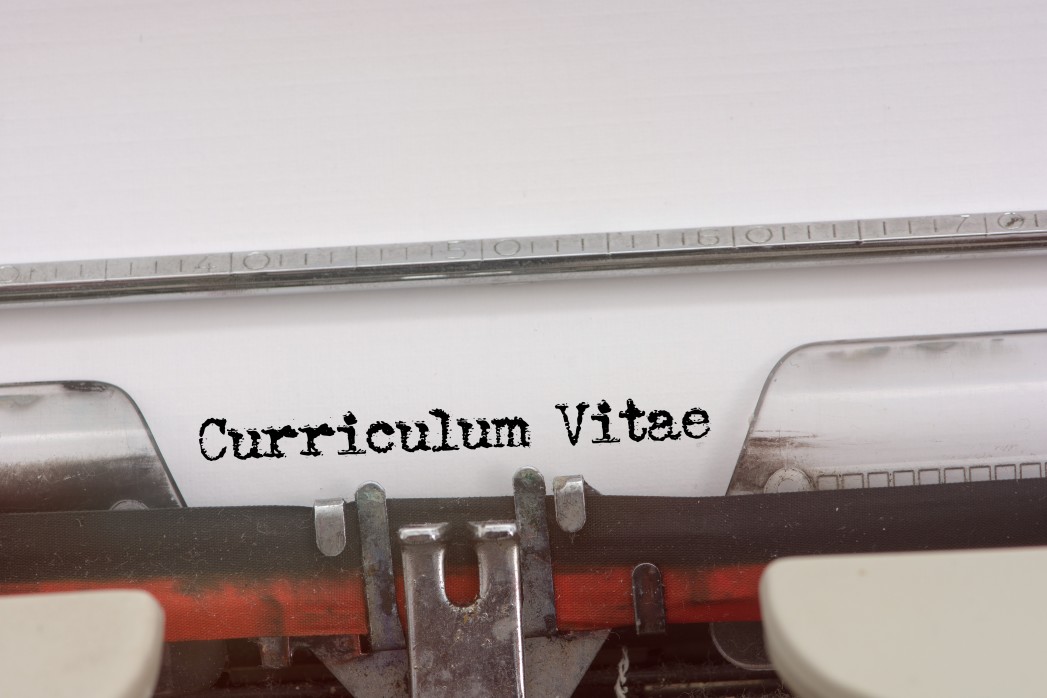
How Long Should a CV be?
In the United States, CVs can be as long as they need to be. Employers do not have strict requirements in terms of CV length. It can be comprehensive, especially for candidates seeking academic or research positions. But ideally, keeping your CV to two to three pages helps the hiring manager better digest your experience for the position you are applying for.
An experienced academic professional or researcher may have a CV that runs three or more pages long and which includes all of their work experience, accomplishments, publications, and other pertinent information. However, a CV for a job seeker with limited work experience and candidates currently in the early stages of a graduate school career shouldn’t exceed three pages in length.
CV Writing Sample
Still in need to see all this put together to get a good idea of what a CV should really look like? Check out our sample below for a student who recently completed a PhD in a research-based field and is looking for a job in academia or a research field:
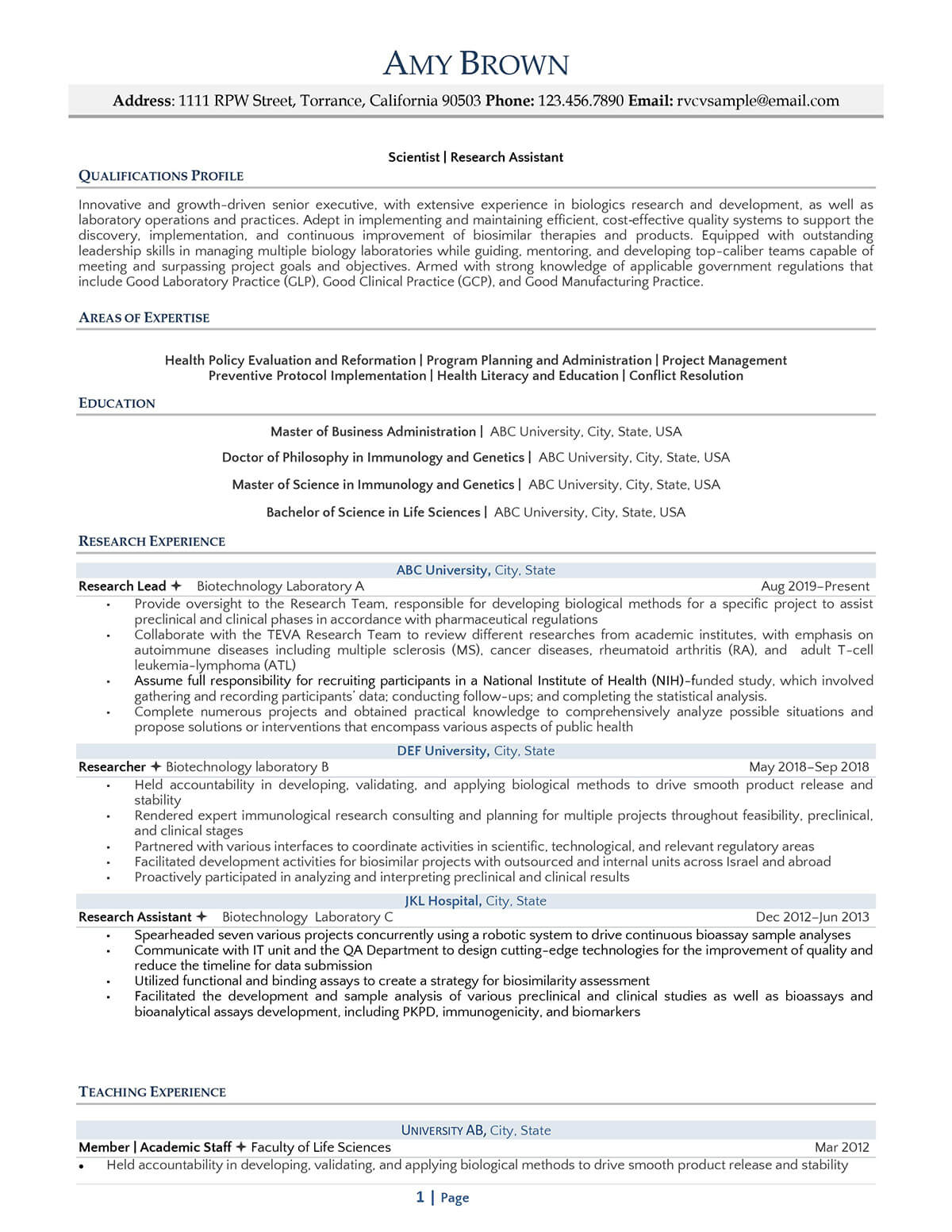
Heed These CV Dos and Don’ts—and Make Your CV Stand Out
Whereas CV writing can be difficult, this list of CV dos and don’ts can help you get started. So, if you’re putting together your CV, make sure to follow these guidelines to avoid the most common pitfalls and red flags in CV writing. That should increase your chances of getting more interviews and landing the new job you’ve been looking for!
Need some help? A professional resume writer can be of great assistance if you’re still having a hard time writing your CV. We at Resume Valley are more than eager to help! Our team of career experts can provide you not only with the pro tips we’ve discussed above but also with CV samples and writing services that best suit your needs. Contact us today!
Related Post

7 Good Work Habits You Need to Develop and Practice to Achieve Career Success

Creative Resume 101: What Works in the Current Employment Market

The Resume Trends to Ace Job Search (Plus the Red and Green Flags of Resume Writing)
Helpful links.

Press Enter to search
The Ultimate Do’s and Don'ts of Resume Writing in 2024
Wondering what belongs on your resume and what doesn’t? Here’s the ultimate list of resume do’s and don’ts in 2024, straight from the mouths of top recruiters
a year ago • 5 min read
Not sure what the do’s and don’ts are of writing a resume in 2023? The good news is that while a few things have changed, there’s also a lot of good resume advice out there that’s still valid. The bad news is, there’s a lot of bad resume advice out there, too, and it can be difficult to figure out which is which.
We talked to recruiters about their most up-to-date resume advice to find out what you should — and shouldn’t — do when applying for jobs. Keep reading as we explore the do’s and don’ts of:
- How to format your resume
- What to include in (and exclude from) your resume
- Avoiding common resume mistakes
- Making your resume stand out for the right reasons
Before we dive in, let’s take a look at what’s changed about resumes and job seeking in 2023.
Resume writing: What’s new in 2023
The reign of artificial intelligence.
AI is making its presence felt in all areas of hiring right now. Alongside Applicant Tracking Systems (ATS), which have been used for a while to speed up and automate parts of the hiring process, ChatGPT is making its presence felt in a number of different fields. That means you should:
- Optimize your resume for ATS (see our formatting tips below for details about how to do this).
- Emphasize new and in-demand skills like Artificial Intelligence, Machine Learning, and ChatGPT .
- Use AI-powered resume scanners to your advantage.
On the topic of AI-powered resume scanners, upload your resume to the below to ensure your sections and bullet points are correctly identified. It’ll also give you feedback on how to improve your resume’s impact and bullet points.
The explosion of remote work
While some companies have issued “return to office” mandates, for most, remote and hybrid work is here to stay. If you’re interested in remote work, make sure to:
- Explicitly indicate that you’re open to working remotely.
- Mention past remote jobs on your resume.
- Lead with accomplishments related to working or managing employees remotely .
- Include must-have skills for remote work, e.g. Zoom, Microsoft Teams, Basecamp, Slack, Trello, and Asana.
The rise of gig economy and side hustles
Through a mixture of choice and necessity, we’re seeing more and more people opt out of a strict 9 to 5 and into side gigs. If this is you, you don’t need to leave these side hustles off your resume — instead, you should:
- List freelance work or self-employment under a single company name (using your own name is fine for this).
- Consolidate multiple short-term jobs under a single heading.
- Emphasize transferable skills through your bullet point accomplishments.
Now that you know what’s new, let’s dive a little deeper into some perennial resume do’s and don’ts.
Appearance: Formatting your resume for maximum impact
Do: prioritize readability and consistency.
Why are we starting with formatting instead of content? Because people need to be able to read your resume before they can understand what’s in it.When formatting your resume, you should:
- Use a standard word processing program like Microsoft Word or Google Docs.
- Choose a single font to use throughout the document.
- Use a readable font size.
- Keep your text left aligned.
- Use capital letters , bold, italics, and larger fonts for emphasis (e.g. larger section headings, bold for job titles, italics for company names).
- Clearly label your resume sections with headings like “Work Experience,” “Education,” and “Skills.”
- Choose a single date format and use it consistently.
- Set one inch margins on all sides.
- Limit your resume to less than two pages ( one page is ideal in most cases).
- Save your resume as a PDF file to preserve your formatting.
DON’T: Fix what isn’t broken
If that sounds like a lot of rules to remember , all you really need to know is this: The less you change from your default settings or resume template, the better.
This means you shouldn’t:
- Change the default settings on whatever program you’re using unless you need to.
- Use a fancy image-based resume creator like Photoshop or online resume generators.
- Use downloaded fonts that may not show up properly on a hiring manager’s computer.
- Add photographs, images, charts, or infographics.
- Make your font size or margins bigger to hide a lack of content or smaller to fit more information.
- Use a multi-column layout — one-column templates are easier for ATS to read.
Content: What to include (and not include) in a resume
Do: include relevant information that makes you a stronger candidate.
Everything that goes on your resume should either be a) essential information that recruiters expect to see (like contact information and work history), or b) directly answer the question, “why are you a good fit for this job in particular?”
Here’s a brief rundown of what your resume should include in each section.
Resume header
- Basic contact details — your full name, phone number , and email address .
- A link to your LinkedIn profile, GitHub , or online portfolio if it’s relevant and well-maintained.
- A resume title and (optional) summary with a brief overview of your key skills and experience.
Work Experience
- List your professional experience in reverse chronological order, starting with your most recent or current position.
- Include the name of the company, your job title, the location, and the dates you worked.
- Add 3-6 bullet points highlighting your accomplishments (not responsibilities) — structure these in the format of “Action Verb + Task + Metric.”
- List your educational qualifications in reverse chronological order, starting with the most recent degree or certification.
- Include the full name of the educational institution, the degree or certification obtained, and the date of graduation or expected graduation.
- If applicable, provide additional details such as your major or field of study, academic honors or distinctions, relevant coursework , research or thesis projects , and study abroad .
Additional information
- Include 1-2 additional sections — for example, Skills, Projects, Volunteer Work , and Extracurricular Activities .
- Explicitly mention any hard skills listed in the job description — these are essential keywords that ATS are programmed to look for.
- Add any other industry-relevant skills, including technical skills, software, coding, and language skills.
DON’T: Add so much information that the important stuff gets lost
The real trick that’s missing from a lot of careers advice is that your resume isn’t about adding as much information as possible — it’s about sticking to the most relevant information and leaving out everything else.In other words, you shouldn’t:
- Include unrelated jobs. Your part-time gig at a fast-food joint absolutely belongs on your resume if you’re applying for a job in food service, but it may not be relevant for a software engineering position.
- Include much older jobs. Unless you’re applying for a senior role requiring 10-15+ years’ experience, leave anything older than that off your resume.
- Write a resume objective. These have been outdated for a long time — opt for a resume summary instead.
- Write in full paragraphs. Your accomplishments should always be in bullet point format .
- Use personal pronouns like “I,” “me,” or “my.”
- List soft skills (like teamwork and communication) in your skills section — instead, choose accomplishments that illustrate those skills in action.
- Include a references section. There’s also no need to write “references available on request.”
- Mention hobbies, activities, or other personal information unless it directly ties in with the job you’re applying for.
- Add links to your personal social media platforms.
- Include personal details like your age, religion, or marital status, which are legally protected against discrimination.
Polish: Common resume mistakes (and how to avoid them)
Here are a few final examples of do’s and don’ts for your resume.
DO: Personalize your resume to each job you apply for.
DON’T: Include trendy but meaningless buzzwords or corporate jargon.
DO: Demonstrate the impact of your accomplishments by using numbers whenever possible.
DON’T: Lie (or exaggerate) on your resume . Anyone who says this is normal resume behavior is, well, lying.
DO: Proofread your resume carefully to avoid typos and grammatical mistakes , which are easy to overlook and could cost you the job.
- Career Advice
Spread the word
How to say you’re not proficient, but have a skill on your resume, crafting a standout business owner resume in 2024: a comprehensive guide, keep reading, how to show bilingualism on your resume (with examples), oops what to do if there’s a mistake on your resume, getting the basics right: resume line spacing, subscribe to our newsletter.
Stay updated with Resume Worded by signing up for our newsletter.
🎉 Awesome! Now check your inbox and click the link to confirm your subscription.
Please enter a valid email address
Oops! There was an error sending the email, please try later

Thank you for the checklist! I realized I was making so many mistakes on my resume that I've now fixed. I'm much more confident in my resume now.


IMAGES
VIDEO
COMMENTS
Therefore, it should be compelling, attention-grabbing and tailored to the particular position. Here are three steps to take to create a compelling and effective personal statement: 1. State who you are. Start with a statement detailing where you are in your career. This should communicate your current position in your profession and field of ...
Include tangibles - always try to give additional details that add value to your application, for instance, quantifying something always makes it sound better. 'Increased sales by 35%' sounds better than just saying 'increased sales'. Hit key points - a good personal statement will be able to give the employer a quick summary of you and ...
A resume personal statement should include: Between 50 and 200 words in 3 - 4 sentences. Your title or function, for example "Junior developer" or "Passionate hospitality manager". An opening hook. Soft skills and hard skills. Impressive facts and stats. Your short and/or long-term goals.
Don'ts. Don't be modest or shy. You want your passions to come across. Don't exaggerate - if you do, you may get caught out in an interview when asked to elaborate on an interesting achievement. Don't use quotes from someone else, or cliches. Don't leave it to the last minute - your statement will seem rushed and important ...
Do not switch between first- and third-person as that will get confusing to the hiring manager. Writing a personal statement for your CV in first-person does not mean you need to start every sentence with "I.". There are ways to craft your personal statement to sound snappy, concise and personal, and here are a few examples to help inspire ...
Here's a personal statement from an administrative assistant's CV that shows you how to write your own: 2. Customer service CV personal statement. This personal statement for a customer service CV underscores the applicant's years of experience with strategic bolding and showcases their customer service skills: 3.
Confuse it with your cover letter - Your personal statement is meant as a short introduction. Keep it that way. Small representations of your success (e.g. a Financial Analyst with eight years' experience) are necessary - but keep them brief. Use your cover letter and employment history to elaborate on your achievements and your personal ...
Repeat CV: offer new insights, not duplicates. Undersell: highlight your achievements. Ignore basics: address 'Who you are' and 'What you offer'. Remember, your personal statement is your opportunity to make a memorable first impression. Keep it relevant, engaging, and reflective of your unique professional journey.
Learn the dos and don'ts of drafting the perfect resume personal statement to make the best first impression on recruiters for any job applications in 2022. A resume personal statement should be short and crisp, containing only the important points that highlight the level of your professional status. Adding the right set of skills and keywords ...
It's a personal statement—it's okay to write about your strengths and accomplishments. Most people aren't comfortable bragging about themselves. But that is exactly what to do in your personal statement. Talk about: Sccomplishments. Good deeds. Moments where you made yourself proud. Just be sure to do so tastefully.
A chronological CV may be confusing and puts you at risk of being overlooked by employers. And don't include too much detail on junior roles - a job title, dates and one line will do. Share too much information in your personal statement. Potential employers do not need to know about divorces, break ups or custody agreements.
The best personal statements are short and concise. Cut out anything which is not relevant to the job. Aim for roughly 100-200 words. Make sure you cover the key information: who you are, what you can bring to the role, and what career goals you hope to achieve in the future. Using these three key points as guidance will help keep your personal ...
Crafting a compelling personal statement requires time, reflection, and attention to detail. By following these do's and don'ts, you can create a personal statement that effectively communicates your strengths, experiences, and aspirations. Remember, your personal statement is your opportunity to shine, so make it count.
8 do's and don'ts for resume writing Here are eight do's and don'ts to consider when writing your resume: 1. Relevant experience Do: List your specific experience, skills and accomplishments that are directly or closely related to the job you want to secure. Include previous positions that had similar responsibilities or positions that allowed you to practice relevant skills.
35. Do Align Your Dates and Locations to the Right. This small change will make your resume way easier on the eyes. You should be able to make a "column" of dates and locations for each job by creating a right tab. 36. Don't Use More Than Two Lines Per Bullet.
Understanding the do's and don'ts of resume writing can help you make an excellent first impression on a hiring manager. A sloppy or incomplete resume, on the other hand, may instantly remove you from consideration for a position. Before submitting your resume, check it against the list of resume do's and don'ts in this article.
2. DON'T address your weaknesses in the personal statement. Use an addendum.The personal statement should highlight the positives about you. 3. DON'T focus on your high school activities or accomplishments. Focusing on achievements in high school can draw attention to a lack of similar achievements in college. 4.
CV Dos and Don'ts: Tips on How to Craft an Effective One 2 CV Dos and Don'ts: Keys to Landing a Job Interview In any job search, an ineffective job application document can make you look unfit for the role and thus ruin your chances of getting callbacks for job interviews.On the other hand, if written professionally, there's a high probability that you'll stand out from the pack and blow ...
The personal statement is the only place in your application where you can showcase your writing skills. A poorly written personal statement may cause a program to reject your application. DO show your personal statement to others to obtain their feedback and for proofreading, but not for their rewrites. It is good to reach out to friends and ...
Don't - Quantity. Stop mass-spamming your resume to every business in a 50-mile radius. That's bad resume etiquette, and you'll just get mass-rejected. Do - Quality. Tailor your resume to the job description: write a resume for this one job, as if no other jobs exist.
1. The dos and don'ts of listing your work experience. Here are some do's and don'ts for listing work experience on your resume:. Do add job-relevant experience to your resume. Recent resume statistics show that a majority of employers want job applicants to submit targeted resumes.. To impress these hiring managers, you should customize your resume for each job listing by highlighting ...
Here are a few final examples of do's and don'ts for your resume. DO: Personalize your resume to each job you apply for. DON'T: Include trendy but meaningless buzzwords or corporate jargon. DO: Demonstrate the impact of your accomplishments by using numbers whenever possible. DON'T: Lie (or exaggerate) on your resume.